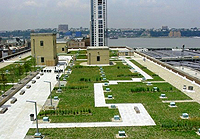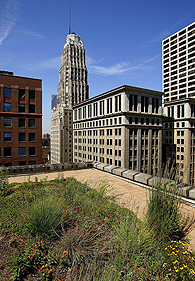The low scrubland of densely packed succulents is in full fall color, a carpet of green fading brilliantly to red and gold. This 2.5-acre oasis, located among a barrens of blacktop roofs that stretches east to Broadway and west to the Hudson River, would be an impressive sight even if it wasn’t sitting atop the U.S. Postal Service’s 1933 landmark Morgan Processing and Distribution facility in midtown Manhattan.
The biggest green roof in New York City and one of the largest in the country, the Morgan facility’s verdant covering was completed in December 2008 and has thrived since. As the inscription above the landmark James Farley Post Office might have it, the roof has been affected by “neither snow nor rain nor heat nor gloom of night,” and has flourished through freezes and thaws, through summer rooftop temperatures that reach 150 degrees, and through weeks of drought and torrential summer storms, despite never being watered, weeded, or fertilized.

The vegetation is a densely planted assemblage of some 25 hardy, low-growing species that have thrived in their few inches of planting material. The plants’ size and modest requirements, however, belie their substantial biological capacities and environmental benefits. Since the roof has been installed, the building’s storm water runoff into the New York municipal water system has been reduced by as much as 75 percent in summer and 40 percent in winter. The U.S. Postal Service estimates that the plants’ ability to cool the roof in summer and insulate it in winter will reduce the building’s energy costs by $30,000 a year.
The sprouting of a large, living roof in midtown Manhattan is a sign that this universally lauded green practice, which has spread rapidly across Europe, is now gaining a serious foothold in the U.S. Although initially more expensive than standard asphalt or shingle roofs, green roofs offer major environmental and economic advantages, from slashing storm water runoff and energy costs, to cooling overheated cities and cleaning their air.
Chicago, which now has more green roofs than any other U.S. city, last year added 600,000 square feet of green roofs and has some 600 projects that will bring its total to 7 million square feet. Washington, D.C. added 190,000 square feet in 2009 and has set a goal of 20 percent green roof coverage by 2020.
In Europe, Stuttgart and Copenhagen have begun to mandate green roofs on most new construction.
In Portland, Oregon, the city provides incentive grants of $5 per square foot for what they call “eco-roofs.” There’s no limit on the size of the roof, but Tom Liptan, a storm water specialist with the city, says that most of the grants have so far gone to homeowners or to buildings in the commercial district. “It was a cost/benefit evaluation,” says Liptan. “The issue here was storm water. We were trying to find a way to reduce the burden on the city. If we trap it on the roofs, we don’t have to build bigger pipes to carry it or cisterns to store it for treatment.”
Liptan figures that if half the roofs in the city were green, Portland would reduce its storm water burden by some 3 billion gallons, a quarter of the rainfall that hits the city’s roofs annually.
This year Toronto became the first city in the Western Hemisphere to mandate green roofs. New buildings with a total floor area of more than 21,527 square feet will, depending on their size, have to cover from 20 to 60 percent of their roofs with vegetation. A 2005 study calculated that if 75 percent of the flat roofs in the city were greened, Toronto could reap $37 million a year in savings on storm water management, energy bills, and costs related to urban heat island effects.
In Europe, green roofs have been a proven technology for nearly 30 years, as a low flight over Stuttgart, Germany — courtesy of Google Earth — will show. Up Eberhardstrasse approaching Marktstrasse, along Friedrichstrasse to Hauptbahnhopf, the central train station, and north of the city center along Oswald-Hesse-Strasse, there’s often more green to be seen on the rooftops than on the ground (including the vast 27-acre green rooftop of the Daimler company). While most cities in the U.S. measure their green roof area in thousands of square feet, Stuttgart can measure its in millions. Some 20 to 25 percent of the city’s flat roofs are green and, due to a combination of government incentives, tax abatements, and regulations, so are 10 percent of the roofs throughout Germany. Cities such as Stuttgart and Copenhagen have begun to mandate green roofs on most new construction.
‘There’s no place to go in nature to find anything like a green roof system.’
The basic green roof consists — bottom to top — of a structural frame covered by a waterproof membrane, an inorganic barrier layer that prevents roots from penetrating into the membrane, a layer of gravel or thermoplastic material to provide drainage, a layer of fibrous material for moisture retention, and, finally, the porous planting medium — volcanic pumice, chipped shale, or even ground up roofing tiles. This planting stratum is mostly inorganic, lightweight, and absorbant, while containing enough mineral content to allow plants to grow.
The roof itself can be made of a single large structure or pieced together using modules. There are prefab designs and even those that can be rolled out like sod, with plants already on them. What are called extensive green roofs are usually planted with low-growing plants — heat- and drought-resistant species such as sedums, or grasses such as allium. These roofs are essentially maintenance-free. Green roofs planted with larger and more demanding species — shrubs, trees, flowering plants — require the watering and weeding needed by any garden.
“You’re using a biological system to address urban problems that we’re used to addressing with mechanical systems,” says Ed Snodgrass, owner of Maryland-based Emory Knoll Farms and Green Roof Plants, who has provided over a million-and-a-half square feet of green for some 250 green roofs. These roofs provide a host of benefits, including eliminating the need to develop new ways of containing storm water runoff.
Click to enlarge
“I tell developers the green roof is performing a service for the building,” says Snodgrass, author of The Green Roof Manual. “And it can be done with a minimum amount of cost.”
Yet the green roof, Snodgrass points out, is not anything like a natural ecosystem. “Everything is designed — there’s no natural analogue,” he says. “There’s no place to go in nature to find anything like a green roof system.”
While varieties of succulents and cactuses, as well as short grasses from the allium family, have proven to be successful green roof plants, nothing seems to succeed like sedums. A large and diverse genus of flowering plants, with some 600 species, sedums can shut down their systems in extreme heat and drought to keep from losing water to evaporation. As the temperature drops and humidity rises, they can, in a matter of minutes, begin to respire again. “If you wanted to design a plant for the conditions on a green roof,” says Snodgrass, “it would be a sedum.”
Once the green roof has been established, scientists have seen, nature takes its own course. The plants provide their own nutrients and, in more polluted areas, even utilize nitrogen in the city air for growth. Insects that feed on nectar visit or colonize the green roofs and spiders that feed on the insects follow.
Green roofs also reduce the amount of pollutants in the storm water that does run off and provide habitat for birds. Cities struggling with already burdened storm water treatment plants — which means most cities — would welcome the millions, even billions, of gallons of water that green roofs might retain. The roofs could also dissipate the effects of summer temperatures where dense development has created intense heat islands.
According to a New York study, green surfaces would substantially reduce the city’s heat island effects.
The major obstacle to the spread of green roofs is the initial cost, which can be anywhere from $15 to $35 per square foot, some two to three times the cost of a non-green roof. But as Shalini Mohan — vice president of URS Corporation, which installed the Morgan postal facility’s roof — notes, green roofs last far longer than standard flat roofs. The Morgan’s roof cost $5 million, nearly double what a plain roof would have cost, but whereas a flat roof would have to be replaced in 15 years, the green roof will last 50.
And then there are the benefits reaped by the city. A recent, as yet unpublished, study says that if an estimated 1 billion square feet of New York City’s roofs were greened, the city’s annual storm water flow could be reduced by at least 10 billion gallons, equal to one-third of the city’s combined sewer overflow. In addition, the study states, the green surfaces would substantially reduce the city’s heat island effects, which are expected to worsen with climate change. Under a proposed Green Infrastructure Plan, the city would develop standards for green roof design and implementation, as well as incentives for green roofs.
Chicago’s growing number of green roofs have been built with no city incentives, grants, or tax breaks, according to Larry Merritt, spokesperson for the Chicago Department of Environment. “We led by example,” he says, noting that in 2001 a green roof was installed on City Hall. Since then, the movement has gathered momentum.
“Chicago City Hall shares a square block with the Cook County municipal building,” says Merritt. “The county doesn’t have a green roof. And we found that on a hot summer day, the City Hall roof is 80 to 90 degrees cooler than the county’s roof.”
Snodgrass says he’s seen the green roof industry in the U.S. grow substantially over the last several years. According to Green Roofs for Healthy Cities, an industry association, roughly 10 million square feet of green roofs were built in 2009, compared to a million in 2004.
“The biggest obstacle for many is the initial cost,” says Brad Rowe, a professor of horticulture with Michigan State University’s Green Roof Research Program. “But that’s because we tend not to look at the long term. The technology is proven. The economics are clear. It’s not just a feel good effort.”